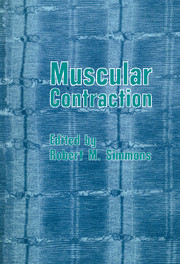Book contents
- Frontmatter
- Contents
- Dedication
- Contributors
- Preface
- 1 A. F. Huxley: an essay on his personality and his work on nerve physiology
- 2 A. F. Huxley's research on muscle
- 3 Ultraslow, slow, intermediate, and fast inactivation of human sodium channels
- 4 The structure of the triad: local stimulation experiments then and now
- 5 The calcium-induced calcium release mechanism in skeletal muscle and its modification by drugs
- 6 Hypodynamic tension changes in the frog heart
- 7 Regulation of contractile proteins in heart muscle
- 8 Differential activation of myofibrils during fatigue in twitch skeletal muscle fibres of the frog
- 9 High-speed digital imaging microscopy of isolated muscle cells
- 10 Inotropic mechanism of myocardium
- 11 Regulation of muscle contraction: dual role of calcium and cross-bridges.
- 12 Fibre types in Xenopus muscle and their functional properties.
- 13 An electron microscopist's role in experiments on isolated muscle fibres.
- 14 Structural changes accompanying mechanical events in muscle contraction.
- 15 Mechano-chemistry of negatively strained cross-bridges in skeletal muscle.
- 16 Force response in steady lengthening of active single muscle fibres.
- References
- Index
2 - A. F. Huxley's research on muscle
Published online by Cambridge University Press: 07 September 2010
- Frontmatter
- Contents
- Dedication
- Contributors
- Preface
- 1 A. F. Huxley: an essay on his personality and his work on nerve physiology
- 2 A. F. Huxley's research on muscle
- 3 Ultraslow, slow, intermediate, and fast inactivation of human sodium channels
- 4 The structure of the triad: local stimulation experiments then and now
- 5 The calcium-induced calcium release mechanism in skeletal muscle and its modification by drugs
- 6 Hypodynamic tension changes in the frog heart
- 7 Regulation of contractile proteins in heart muscle
- 8 Differential activation of myofibrils during fatigue in twitch skeletal muscle fibres of the frog
- 9 High-speed digital imaging microscopy of isolated muscle cells
- 10 Inotropic mechanism of myocardium
- 11 Regulation of muscle contraction: dual role of calcium and cross-bridges.
- 12 Fibre types in Xenopus muscle and their functional properties.
- 13 An electron microscopist's role in experiments on isolated muscle fibres.
- 14 Structural changes accompanying mechanical events in muscle contraction.
- 15 Mechano-chemistry of negatively strained cross-bridges in skeletal muscle.
- 16 Force response in steady lengthening of active single muscle fibres.
- References
- Index
Summary
Light microscopy: sliding filament theory
Andrew Huxley switched from nerve to muscle research in 1951 immediately after completing the papers with Hodgkin on the squid giant axon. He later wrote, explaining the change: “For one thing I had never worked on anything but nerve, and for another, there was at that time (and indeed for a good many years after) no obvious way of pushing the analysis of excitation to a deeper level” (A. F. Huxley, 1977). Huxley's interest in muscle had been kindled when he took over the lectures on muscle to the final-year undergraduate students at Cambridge from David Hill (son of A. V. Hill, and himself a fine muscle physiologist). David Hill passed on his lecture notes, which included a description of some of the nineteenth-century observations of muscle using light microscopy. A number of authors had accurately described the appearance of striated muscle and the way in which the striations change during contraction, though there was a certain amount of conflict in the subsequent literature, particularly about which of the bands – the A-band or the I-band – changes in length when a muscle fibre is stretched or contracts (A. F. Huxley, 1977).
In 1951, knowledge of the structures underlying the striations was sketchy. It was thought that the muscle proteins actin and myosin existed as a complex that ran from end to end of a muscle, and theories of contraction involved a folding of this complex (e.g., Astbury, 1947). Early electron microscopy of muscle using longitudinal sections seemed to confirm this view, apparently showing that the filaments in the Aband and the I-band were continuous, though it was soon to be shown be shown that myosin was located in the A-band.
- Type
- Chapter
- Information
- Muscular Contraction , pp. 19 - 42Publisher: Cambridge University PressPrint publication year: 1992
- 3
- Cited by



